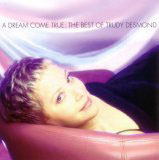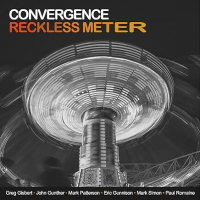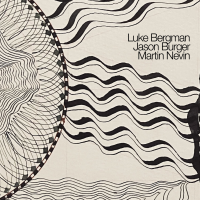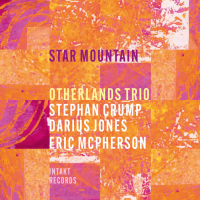Home » Jazz Articles » Multiple Reviews » Rova: John Coltrane's Ascension & Electric Ascension
Rova: John Coltrane's Ascension & Electric Ascension
- John Coltrane, 1965
The Rova saxophone quartet chose this quote from Coltrane, referencing Zen Sixth Patriarch Hui-neng's famous poem, for the liner notes of their first version of John Coltrane's "Ascension." Rova, in its extended format, the Orkestrova, recorded it twice—and unfortunately it's the only group that dared to tackle this groundbreaking and profound work of mostly freely improvised composition.
Rova's first version of "Ascension," celebrating the composition's thirty-year anniversary, was much more faithful to the original instrumentation and arrangement, mirroring Coltrane's concept, while the recent one, performed as part of Rova's 25th anniversary, is much more radical, electric, and electronic. "We felt, If Coltrane was alive in 2003, he would have done the same thing," writes Rova's Larry Ochs in the liner notes to Electric Ascension.
 ROVA
ROVA
John Coltrane's Ascension
Black Saint
1996
The power of "Ascension" lies in the musicians who perform it. The composition itself is at best unassuming on paper, beginning with a five-note pattern that references the "Acknowledgment" section from A Love Supreme, is repeated several times later on, and leaves a plenty of room to the musicians to improvise collectively in different ensembles. Coltrane never rehearsed the composition before recording two versions of it on the same day.
For this live version of "Ascension," recorded in December, 1995 in San Francisco, Rova decided on the same instrumental configuration as the original performance: five saxophonists, two trumpet players, two bass players, a pianist, and a drummer. The late Glenn Spearman was the fifth saxophonist, and the two trumpet players were Dave Douglas and Raphe Malik.
This attempt to mirror Coltrane's composition in its original form, while relying on thirty years of preconceived knowledge of what Ochs calls "structured improvisation," garnered some great solos, most noteworthy by Rova's Bruce Ackley, but it did not create the same overwhelming and intense impact as a first listen to Ascension. Still, this version is a beautiful homage to the great ensemble that performed "Ascension" for the first time, and as saxophonist Marion Brown, who participated in the original recording, said: "you could use this record to heat up the apartment on these cold winter days."
 ROVA::Orkestrova
ROVA::Orkestrova
Electric Ascension
Atavistic
2005
This time Rova did clean the mirror. Rova's arrangers of "Ascension," Ochs and Jon Raskin, radically changed the instrumentation and arrangement, and they managed to create a much deeper tribute to Coltrane's spirit. Rova is augmented by a string section of Carla Kihlstedt and Jenny Scheinman on violins, and a so-called "rhythm & noise" section of Chris Brown, who played the piano on the 1995 version and now is playing electronics; Nels Cline, who performed Coltrane's Interstellar Space as a duet with drummer Gregg Bendian (Atavistic, 1999), on electric guitar; Fred Frith on electric bass; Ikue Mori on drum machine and sampler; Otomo Yoshihide on turntables and electronics; and Don Robinson, who was part of the 1995 ensemble, on drums. This version was recorded live at KFCJ-FM studio in Los Altos in February, 2003, with no thought to releasing the concert on disc.
This revisited interpretation is much more satisfying than the 1995 version, using Coltrane's "Ascension" as a vehicle to a string of re-imagined group improvisations. Cline's dense solo on the second group improvisation is exhilarating; the orchestral electronic blend of Mori, Brown, and Yoshihide is truly unique to this performance; the playful combination of Raskin, Yoshihide, and Robinson enables Yoshihide to improvise beautifully with his turntables on Raskin's themes; and the enchanting and lyrical duo of Scheinman and Kihlstedt on the fifth group improvisation, with its eastern references, is yet another outcome of this fresh arrangement.
This kind of version was not possible forty years ago—not just because of technological advances. Forty years down the road you cannot just blow freely and collectively without a preconceived concept or experience, as was possible during the original recording. As Ochs adds: "forty years later, the concept is not only a known quantity, but it's been absorbed, analyzed, worked on, thought about, discussed, 'improved'." Rova, with its inspired Orkestrova, engages Coltrane's uncompromising compositional attitude and boundaries, pushing with its own sense of informed and masterful improvisation. This marrying of great minds and souls is what makes Electric Ascension such a great triumph. This time Coltrane's music not only heats the nearby atmosphere but also chills out your mind.
Visit Rova on the web.
Related Article
Re-Imagining "Ascension" by Bruce Ackley
John Coltrane's Ascension
Tracks: Welcome; Ascension.
Personnel: Jon Raskin and Steve Adams: alto saxophone; Larry Ochs, Bruce Ackley, Glenn Spearman: tenor saxophone; Dave Douglas, Raphe Malik: trumpets; George Gremaschi, Lisle Ellis: bass; Chris Brown: piano; Donald Robinson: drums.
Electric Ascension
Track: Ascension.
Personnel: Rhythm & Noise: Chris Brown: electronics; Nels Cline: electric guitar; Fred Frith: electric bass; Ikue Mori: drum machines, sampler; Donald Robinson: drums; Otomo Yoshihide: turntables, electronics. Strings: Carla Kihlstedt: violin and effects; Jenny Scheinman: violin. Rova::saxophones: Bruce Ackley: soprano saxophone; Steve Adams: alto saxophone; Larry Ochs: tenor saxophone; Jon Raskin: baritone saxophone.
Tags
PREVIOUS / NEXT
Support All About Jazz
 All About Jazz has been a pillar of jazz since 1995, championing it as an art form and, more importantly, supporting the musicians who make it. Our enduring commitment has made "AAJ" one of the most culturally important websites of its kind, read by hundreds of thousands of fans, musicians and industry figures every month.
All About Jazz has been a pillar of jazz since 1995, championing it as an art form and, more importantly, supporting the musicians who make it. Our enduring commitment has made "AAJ" one of the most culturally important websites of its kind, read by hundreds of thousands of fans, musicians and industry figures every month.





















